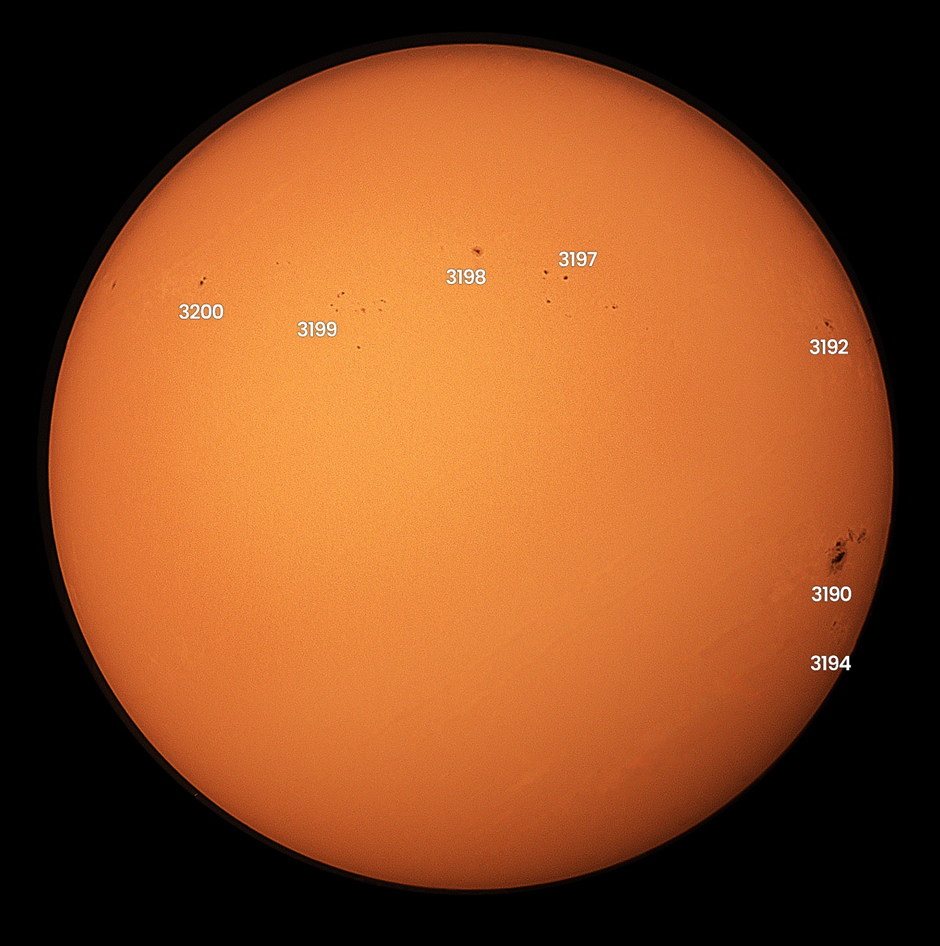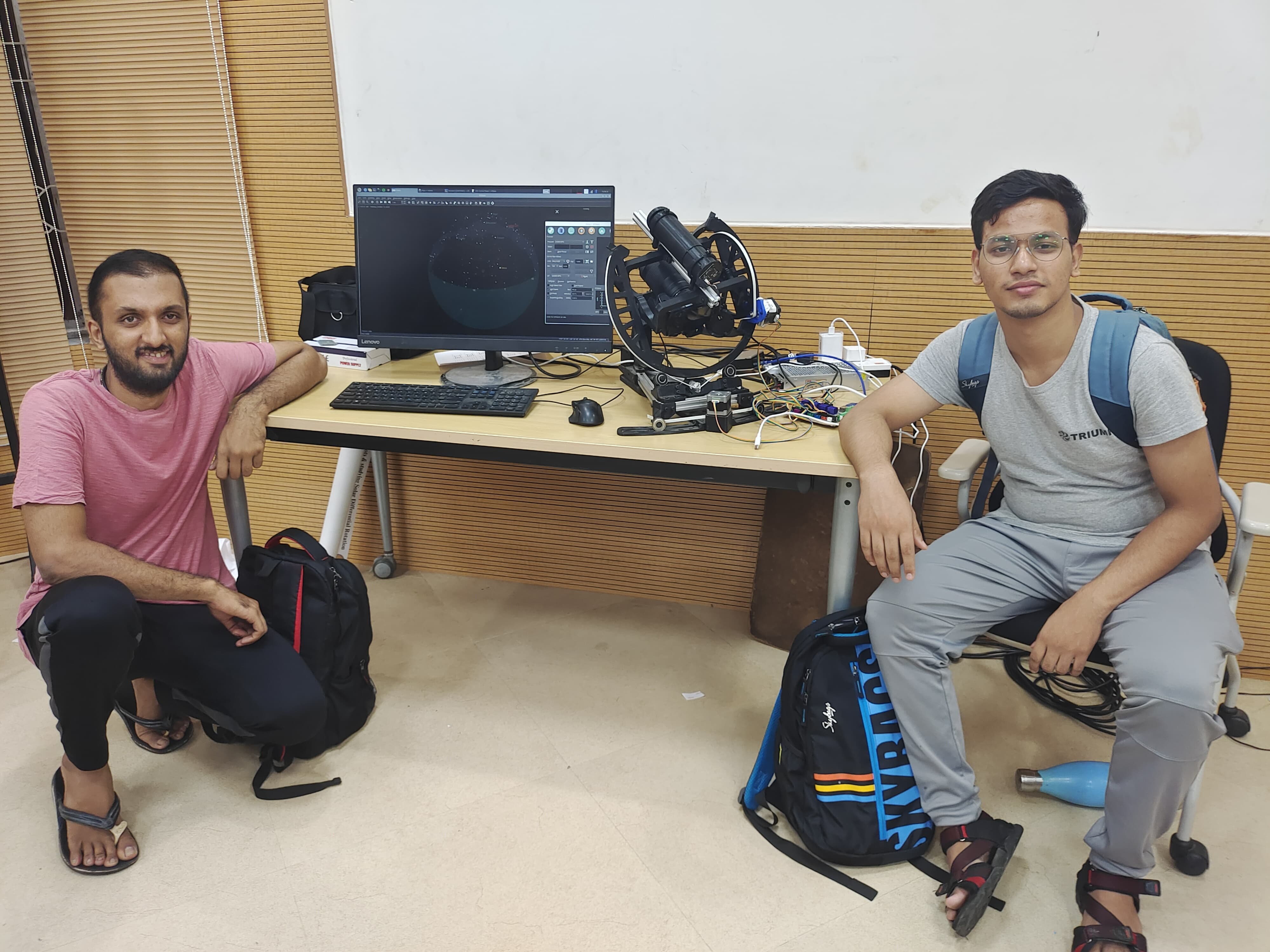| |
Observing Sun Spots
(Team A: Amrit Putcha, Anubhav Prakash, Amna Rayan)
We are a group of students currently engaged in observation and analysis of solar surface phenomena in the visible spectrum.
By means of a DSLR (or/and Dobsonian telescope, 9” aperture) with a 300 mm lens along with ND5 Solar filter, we capture raw images (approx. 1000) of Sun during daytime, mostly around noon, and then process the images to produce a final single “.tiff” image. The final processed image allows us to see the darker and brighter regions (in visible spectrum) of the sun, especially the darker ones, called sunspots.
Sunspots are regions with a high magnetic field on the surface which reduces the amount of light coming from those regions. Thus, when seen through a solar filter, these regions appear as black spots on the solar surface.
Sunspots usually appear in active regions of the sun. The active regions of the suns are labelled by a name in the format, “AR XXXX”, where the X’s are 4 digit number which indicate the order in which the active regions appeared. So, an active region named “AR3490”, was observed before “AR3489”. This naming convention is used worldwide; hence we too have adapted this naming convention. A single active region can have multiple sunspots, and sunspots, being a dynamical feature of the solar surface, can merge or split into two or more. Hence, the number of sunspots in a single active region varies with time. But all the sunspots in the single active region are referred to by the name of the active region.
Sunspots may be considered as markers on the solar surface, which is otherwise almost the same all across its surface as observed with commercial telescopes in the visible region. Their coordinates on the solar sphere doesn’t change appreciably with time, hence as the sun rotates (the fact that sun rotates can be proved by observing the motion of sun spots across the visible side of the sun), the sun spot moves, and this allows us to know the rotation rate of the sun, and also know that the sun undergoes differential rotations (as it isn’t a solid sphere), i.e., different latitude of sun rotates at a different rate.
We intend to create a database on daily solar images (final processed and raw images) and make it open access for anyone and everyone to analyse based on their own interest. We have a team who does the processing and analysis of the images. As of now, we have collected around 2 months of data and created a daily sun image repository which has daily images of the sun of around the past 2 months. Based on our observations till now, we confirmed the statistical fact that sunspots usually form in latitudes between 30 deg - 45 deg north and south of the equator.
 |
Example of a stacked Image of Sun
An example of a stacked image taken by the Telescope is shown here. It is an outcome of processing (stacking and improving aesthetics in photoshop) 379 raw images. The raw images contain noise because of external (atmospheric), and internal (dust specks on the mirror, thermal noise of sensor) factors which are removed to a certain extent in the stacking process resulting in an improved image with higher Signal to Noise ratio.
|
|
Link to our notion website for the above project :
https://solarphotography-iitm-cvk.notion.site/ba050136ab334021b75e56412d58cf6d?v=45c2e328713d4b319a8c54a61adee869
Building Astro-tracker
(Ayush Jamdar, Anubhav Prakash, Anirudh Varna)
The developed Astro-Tracker is an automotive celestial object-tracking system that tracks the position of a particular celestial object to allow long exposure astrophotography. The system consists of a Nikon D3500 DSLR camera mounted on a structure, majorly made out of 3D printed parts and an aluminum extrusion built base, that uses equatorial mount to rotate the camera about 2 angular axes, RA(Right Ascension) angle and DEC(Declination angle) to point the camera towards a particular point in the sky and then move the RA angle for the camera at the right speed to track the celestial object and keeping it fixed in the camera frame thus countering the earth’s rotation for enabling long exposures imaging. We use stepper NEMA17 (0.9°) motors to control the angular motions using TMC2209 motor drivers. The motor drivers are operated using MKS GEN L V2.1 board which is commonly used in 3D printer to control the motors’ motion accurately.
We use RaspberryPi 4 board as the local computer to run and operate the whole system. We use an raspian based OS called Astroberry OS on the RPi board because it allows us to remotely connect to the computer on the astro-tracker over a common wifi-network, using our own PC. Based on INDI library, the whole system along with camera and its setting, are controlled and set using “KStars”, an open source free software to generate accurate graphical simulation of the night sky based on our locations and date/time, and “Ekos”, a complete astrophotographical solution to control the camera and the tracker system.
The system as a whole serves a crucial purpose to allow photography of celestial objects that are extremely hard to photograph manually from earth’s surface. The project is an improved version of an open source project “Open Astro Tracker”. The 3D printed files and the code for the operation were taken from the open source project and were improved and fit to our needs with help from Physics Dept. Workshop, and from our own efforts with coding and 3D modelling.
|

Astrotracker Team
|
Building astro-tracker : https://www.notion.so/StarTracker-023531fc0b5d476993bf65a8da9f5eb9?pvs=4
| |
Complete extended team for all projects |
|